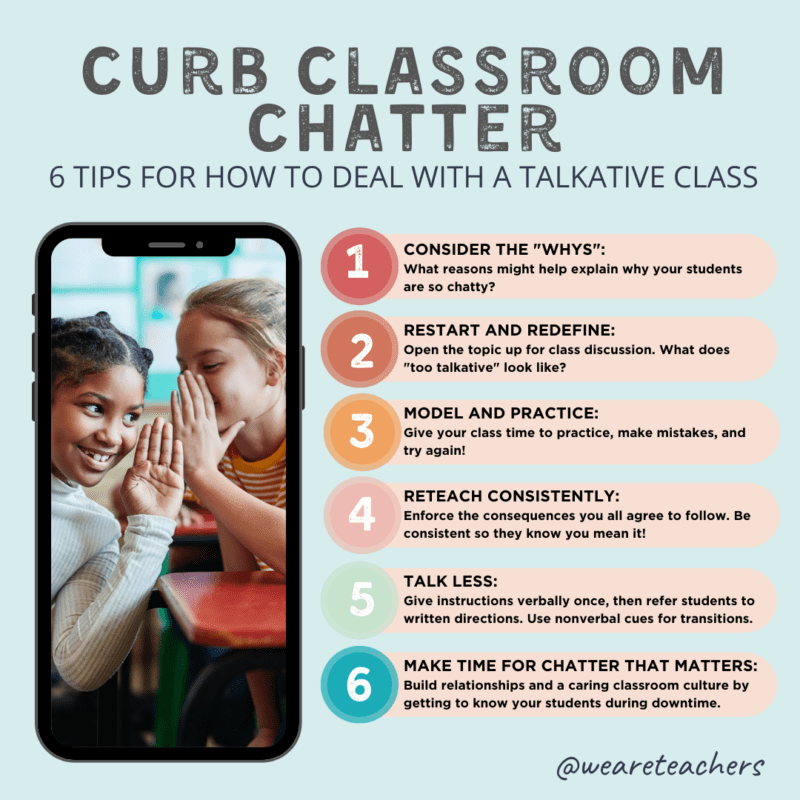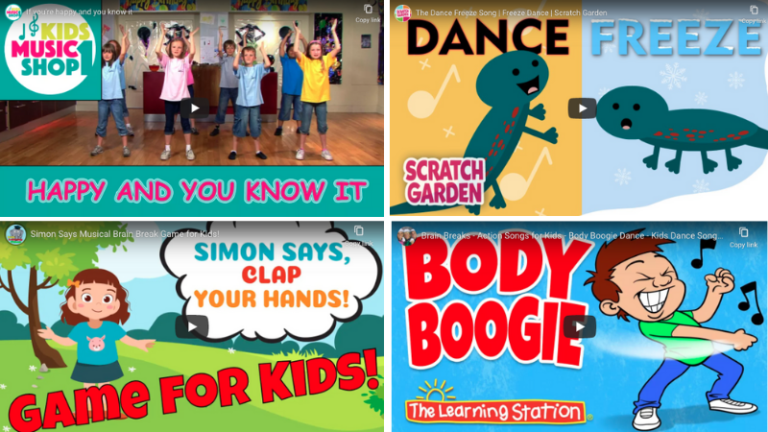A talkative class can be both a blessing and a curse. We all want engaged students, but if they’re more interested in their side conversations than your lesson, the class can quickly turn chaotic. Trying to teach over a talkative class isn’t just miserable; it’s a waste of time. When distracting classroom chatter becomes the norm instead of the exception, it might be time to re-evaluate how to deal with a talkative class.

1. Consider the “Whys”
Before doing anything else, do some investigating. Why are they chatting now when they should be engaged in the lesson. What factors could be impacting their ability (or willingness) to listen?
Do you teach this class right before lunch? Right after? If so, maybe hunger or energy levels are playing a role.
Do your lessons move from high-energy activities where chatter is encouraged to low-energy ones where the students need to work quietly? If so, do they need more practice with transition skills?
What kind of relationship do you have with your students? Do they know that breaking a rule will be met with fair but consistent consequences?
Once you figure out what factors are playing into the behavior, you’ll be in a much better position to address it.
[contextly_auto_sidebar]
2. Restart and redefine
If you have a solid relationship with the students and feel that they will listen to you during a serious conversation, consider bringing the issue to the class as a whole. When you say, “no talking,” what exactly do you mean? Does it need to be pin-drop silent or can students talk to each other if they’re on-task? Can a student ask a peer for assistance? For a pencil? Do you just need that level of quiet when delivering instructions?
Discuss what you would like the room to look like at different times so that your students are very clear on what is expected of them at different times. If needed, make an anchor chart that you and the students can refer to. During instructions, it’s pin-drop quiet. That means no talking to anyone. Bodies, heads, and eyes should be directed toward the teacher/speaker. Active listening skills should be used. During paired work, it’s library quiet. Hushed voices are permitted. You may speak to your partner, but not to other groups. Conversations should be on-topic. Bodies, heads, eyes directed toward partner and task. By going over this and making it clear to your students, you’ll be able to refer back to it when students forget.
3. Model and practice

We have so much to do each day that taking time to model/practice the behaviors we expect our students to demonstrate can feel like time we just don’t have. But remember, by modeling and practicing now, we’re hopefully not going to have to waste all that time correcting these behaviors later on.
Ask students to practice listening to directions silently with a silly activity like listening to a brain-teaser or drawing a picture based only on your verbal instructions. Have students model what active listening looks like during a group discussion. Reflect as a class on what each correct behavior looked like and why it was helpful. When students demonstrate appropriate behaviors, compliment them and thank them for following the classroom norms.
4. Reteach consistently as needed
We can spend an entire week reintroducing, agreeing upon, and practicing the expectations of talking and listening in our classrooms. The students can demonstrate perfect active listening skills. But we know that eventually, they’ll forget (or decide that the latest gossip is more important) and start talking at inappropriate times again.
In figuring out how to deal with a talkative class, it’s important to remember that it’s an ongoing process. And, if we want the new behaviors to stick, we need to be consistent. Let your class know that you’ll be sticking by the expectations and procedures of the class. And then do it. If your policy is to contact parents, change seats, or keep students in for part of recess when they talk during lessons—do it. Letting your student see you follow through on the classroom norms you’ve all agreed to is vital. If you don’t, any improvement you see after your initial discussion will be short-lived.
5. Talk less
No one likes listening to someone else talk for extended periods of time. (Faculty meetings, anyone?) Make sure you’re mindful of how much time you spend talking to your class. If you’ve given instructions verbally, post them on the board too. When a student inevitably asks you to repeat them, point them to the written instructions.
Try nonverbal cues for transition times as well. A doorbell or other sound cue to let them know their partner-work needs to wrap up. A flick of the lights to remind them their group discussions are getting a bit too loud. Train your students to learn that, when you’re speaking, it’s because you have something important and worthwhile to say.
6. Make time for meaningful chatter
When learning how to deal with a talkative class, one of the most important concepts is classroom culture. By creating a classroom culture of respect and understanding, we’re far less likely to have students who choose to talk over us or ignore us when we ask them to stop chatting. The only way to do that is by getting to know our students. Make sure there is time in your schedule to chat with your students about real-life things. Whether it’s the latest show they’re binge-watching to something that happened to their dog this weekend, students are eager to share their lives with us. They also want to know a bit about ours. These are the conversations that often end up meaning the most to our students, so make sure that you don’t accidentally get rid of them altogether when trying to stop them from talking out during inappropriate times.
Have a great tip for how to deal with a talkative class? Share it with others on the WeAreTeachers HELPLINE group on Facebook.


